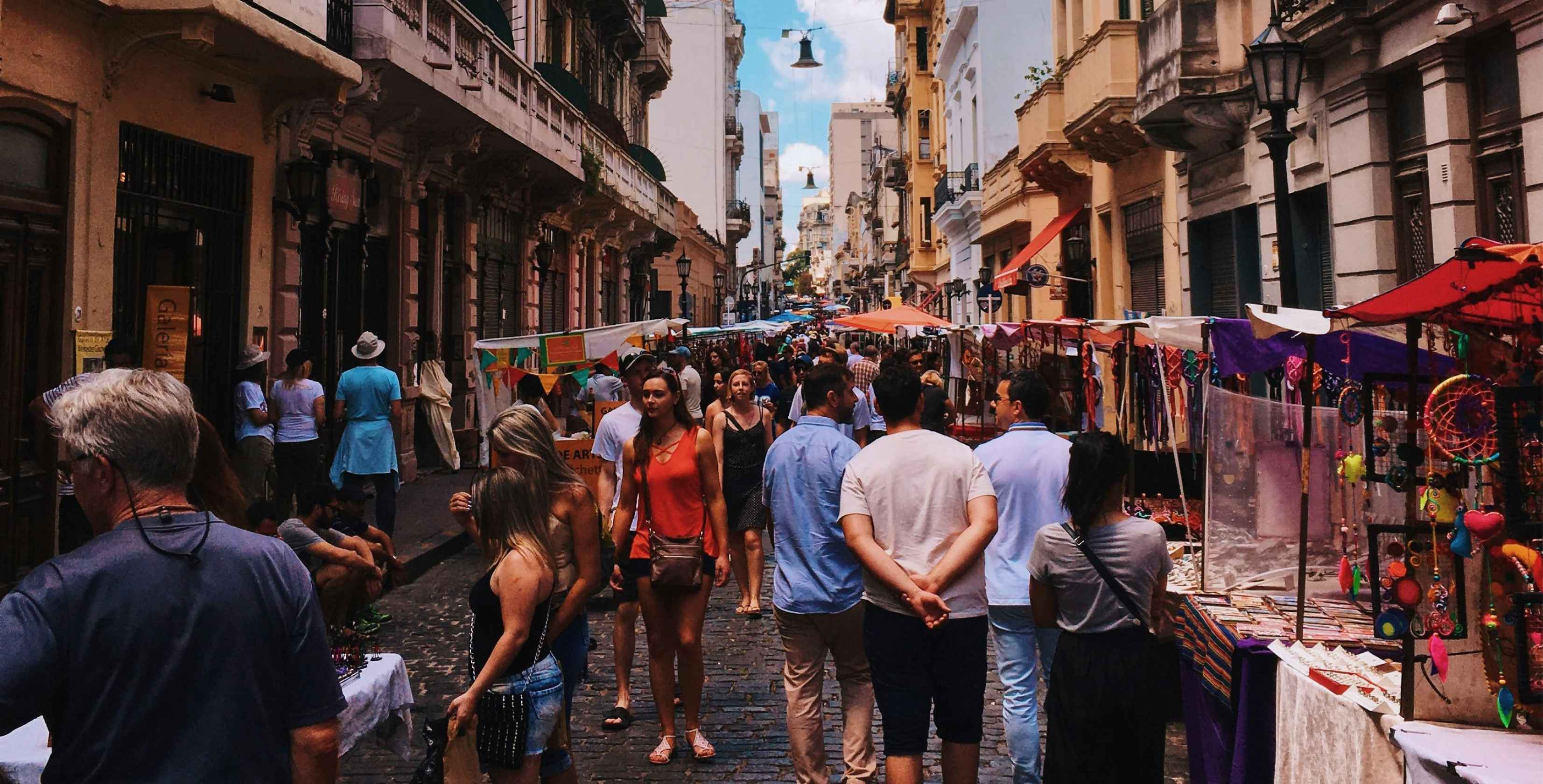The travel tourism industry has always been a dynamic and ever-changing sector, that adapts itself with the global trends, economic shifts, and according to the travel consumer preferences. Keeping the above parameters, a new report has shed light on the market analysis, the contribution of tourism to India's GDP after the global pandemic, and the rising growth of the sector within the travel industry.
According to a report by Statista, it is expected that the market size of the travel and tourism industry in India will grow from US $78 Billion, in 2023 to US $131.7 Billion, by 2030.
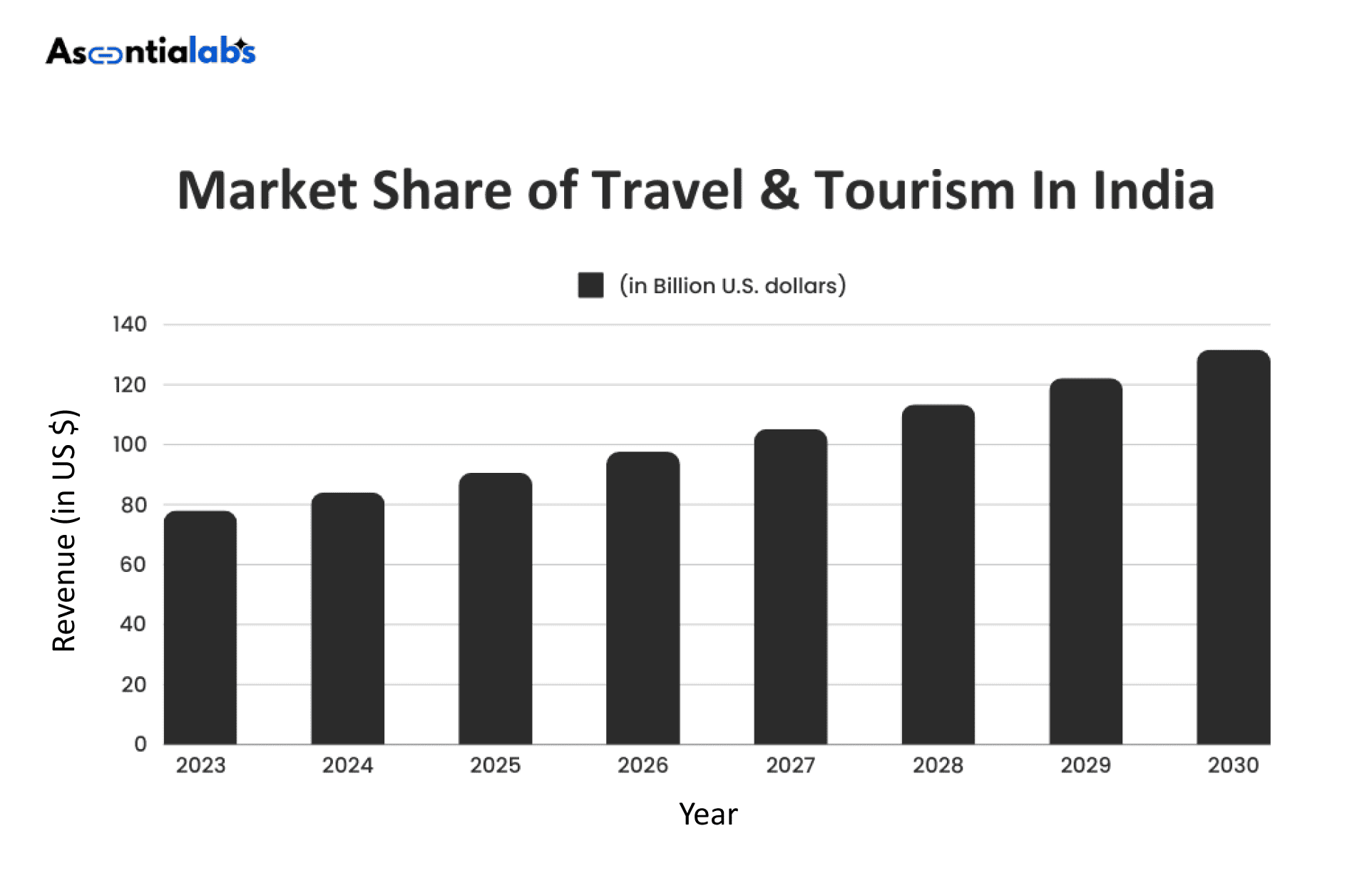
This blog deep dives into the key insights from the IBEF travel and hospitality report, offering readers a core overview of what to expect in the travel and tourism industry in upcoming years in India.
/CTA.png)
Capitalize Your Travel Business In The Rapidly Growing US $927.30 Billion Travel & Tourism Market Size With Latest Tech!
Get In TouchEvolution Of The Travel And Tourism Industry In India
Rising Contribution Of Travel & Tourism Sector In India's GDP
\Blog 2 Image 2.jpg)
\Blog 2 Image 2.jpg)
The data shows that the travel and tourism sector contributed US$ 247.37 Billion to India's GDP in 2019, while the amount came down to US$ 121.9 Billion due to the global pandemic in 2020, the sector showed a positive growth and contributed US$ 199.6 Billion to India's GDP in 2022 accounting almost 5.9% of India's total GDP.
According to the World Travel & Tourism Council (WTTC), the Travel and Tourism sector in India will grow at an average rate of 7.1% annually. WTTC also forecasted that the total number of jobs in the travel tourism sector in India alone will reach an incredible mark of 39 Million by 2024, and will touch the 50 Million mark in the next 5-7 years.
Growth In E-Tourist Visa
The Government of India launched the e-visa on 27 November 2014 and initially launched the e-tourist Visa in 46 countries. Since then, this option has been extended to citizens of 167 countries, and as on 1st April 2024, Japan is the latest country that has been added to the list. E-Visa covers several categories including e-Tourist Visa (30 days/ 1 year/ 5 year), e-Business, e-Conference, e-Medical, and e-Medical Attendant visas. In addition, a special medical visa has been introduced for foreign travelers seeking treatment in India and an electronic medical visa is available to citizens all across 166 countries.
According to a report by Statista, during the period 2021-2022, approximately 2,27,230 foreign tourists arrived in India through E-Visa, a 73% decrease from the previous year due to the impact of the coronavirus pandemic.
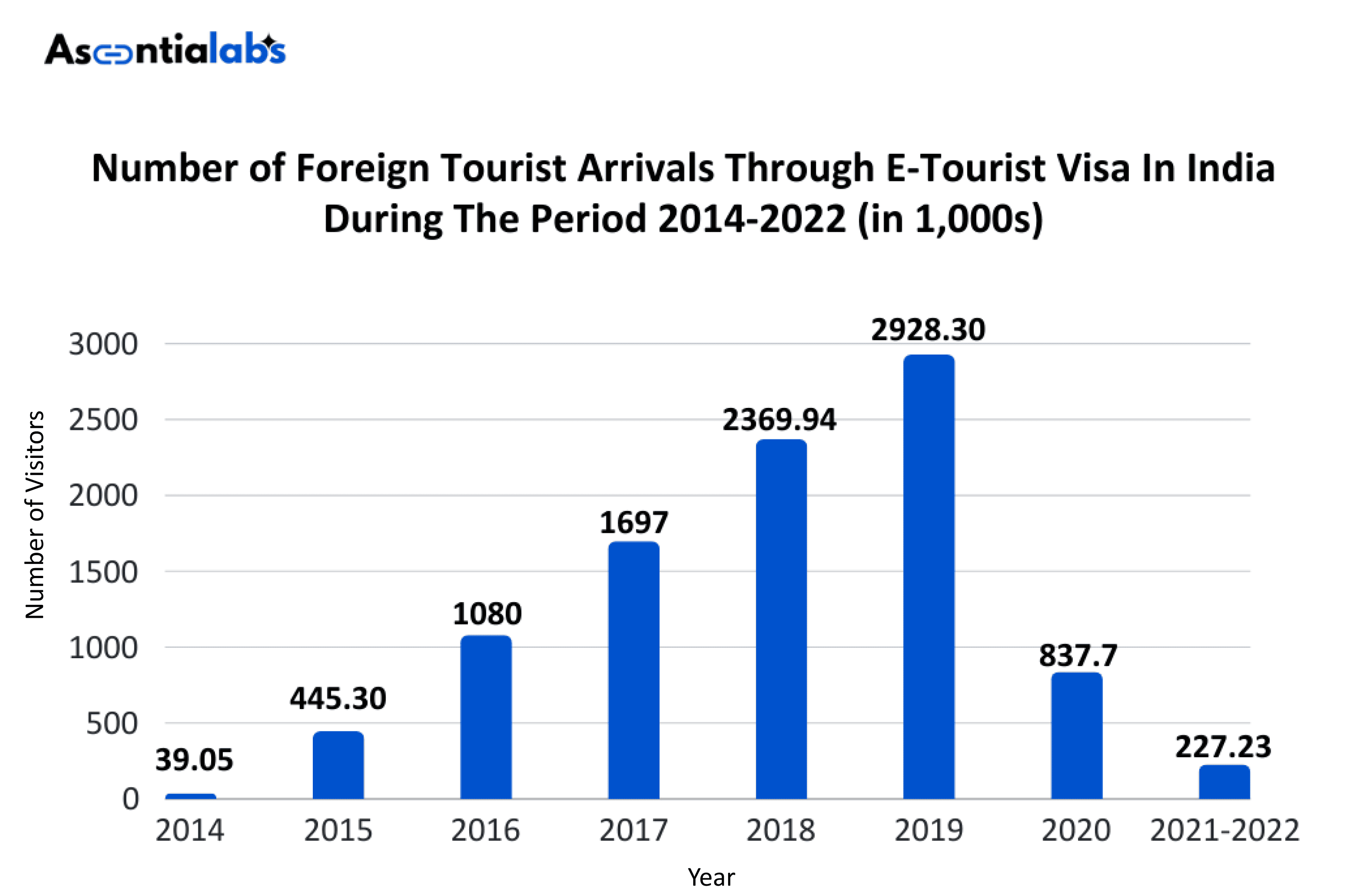
Arrivals of Foreign Tourists in India Post -Pandemic
According to the Ministry of Tourism (MOT), a total of 1.070 million foreign tourists arrived in India in December 2023. There were 9,236,108 FTAs in January-December 2023, compared to 6,437,467 in January-December 2022. Indira Gandhi International Airport (New Delhi) was one of the airports in India with the highest number of foreign tourists (29.92%), followed by. Mumbai Airport (18.46%), Haridaspur Land Check Post (7.09%), Chennai Airport (7.02%) and Bengaluru Airport (6.20%).
The G-20 Presidency also offers India’s tourism sector an unparalleled opportunity to highlight its offerings and share its success stories on a global stage. By 2028, India's travel and tourism sector is expected to earn US$ 50.9 Billion in visitor exports, compared to US$ 28.9 Billion in 2018. The Tourism Ministry has undertaken the ‘Namaste India’ Campaign to encourage international visitors to travel to India. Additionally, the United Nations World Tourism Organisation selected Pochampally in Telangana as one of the best tourist villages in November 2021.
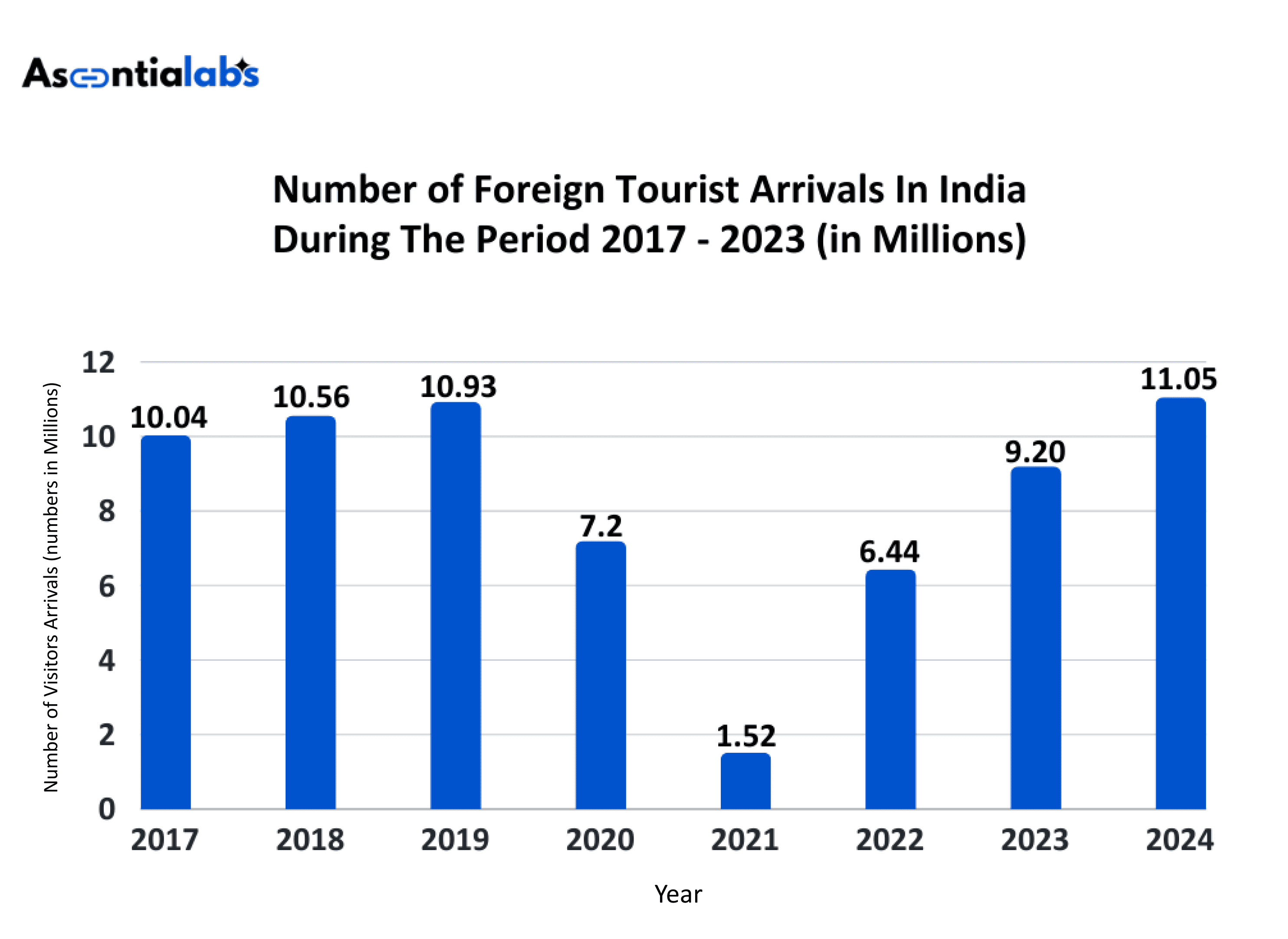
What Attracted Foreign Tourists to India?
Between January and December 2023, 26.52% of foreign tourists visited India to connect with the Indian diaspora, accounting for a total of 9,236,108 visitors. Tourism remains a crucial source of foreign exchange for India, similar to many other countries. Although Foreign Exchange Earnings (FEE) increased at a compound annual growth rate (CAGR) of 7% between 2016 and 2019, there was a dip in 2020 due to the COVID-19 pandemic. In the year 2023, the total revenue from foreign exchange (FEE) from the month of January to December stood at $28.1 Billion.
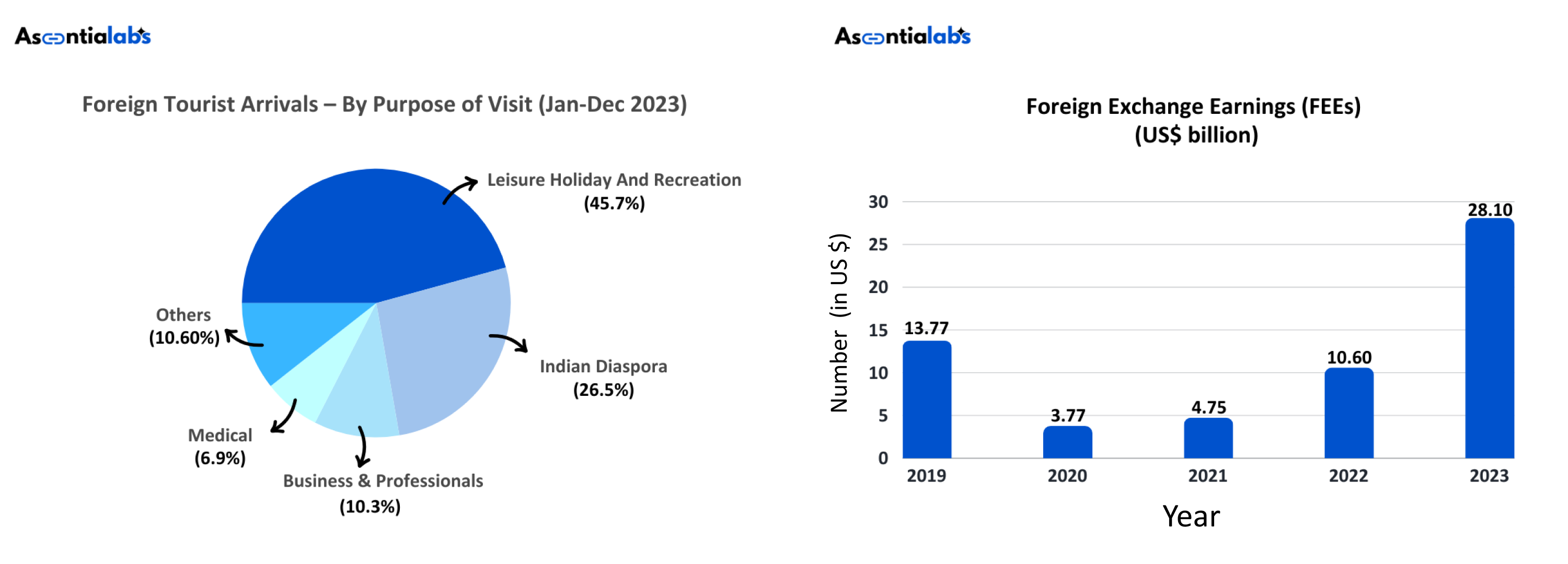
To boost global tourism within the nation, the Indian Ministry of Tourism also introduced the "Namaste India" initiative aimed at attracting additional international tourists to discover India. Moreover, the need for medical tourism in India is expected to expand significantly, with a compound annual growth rate (CAGR) of 19% forecasted from 2022 to 2032.
Domestic Tourism Driving India's Industry Growth
.png)
In December 2023, the highest percentage share of foreign tourist arrivals in India came from the UAE (22.33%), followed by Bangladesh (16.97%), the UK (10.33%), Australia (8.58%), and Canada (4.15%). Domestic visitor spending increased by 20.4% in 2022, only 14.1% below 2019 levels, while international visitor spending rose by 81.9% in 2022, though it was still 40.4% behind 2019 figures. Domestic tourism is projected to further grow to US $405.8 Billion by 2028.
The Ministry of Tourism called a conference of State Tourism Ministers from 18th to 20th September 2022, in Dharamshala, Himachal Pradesh. The objective of this conference was to promote direct dialogue on travel plans, policies, and actions taken at the national level for the overall improvement of tourism in India. In addition, the Ministry of Tourism has promoted India as a 360-degree destination for the international tourism industry by participating in major international travel exhibitions such as the Arabian Travel Mart in Dubai and the World Travel Market in London.
Rising Income & Demographics Boosting Tourism In India
Since 2001, the per capita income in India grew from US $460 to US $1,413 in 2011 to US $2,150 in 2021. In the third quarter of 2024, India's per capita income reached to US $2770.77, and is projected to grow by nearly 70%, reaching US $4,000 by FY 2030, up from US $2,450 in fiscal 2023.
\Blog 2 Image 7.jpg)
The country's economic growth is expected to increase from US $199.63 Billion in 2018 to US $405.84 Billion by 2028. ICRA forecasts nationwide premium hotel occupancy to reach approximately 70-72% in FY 2024, further increasing to around 72-74% in FY 2025, following a recovery to 68-70% in FY 2023. According to Bloomberg Economics' base case scenario, India's economy will see a growth rate of almost 9% by the end of this decade and will overtake China (whose economy will slow down to 3.5% during the same period) as the biggest growth driver by 2028.
Leading States & UTs In India Attracting Tourists
\Blog 2 Image 8.jpg)
India with its diverse culture and history attracts millions of tourists every year. Goa, Maharashtra, Tamil Nadu, Uttar Pradesh, Karnataka, and Andhra Pradesh are some of the states in India that are attracting a larger number of domestic and international tourist to India.
Below are the two tables showing the number of domestic and foreign tourist arrivals in different states of India.
\Blog 2 Image 9.jpg)
Key Companies Role In Travel & Tourism Sector In India
According to figures from the World Travel & Tourism Council (WTTC), the travel and tourism sector contributed Rs. 16.5 lakh crore (US $197 billion) to the Indian economy in 2022.
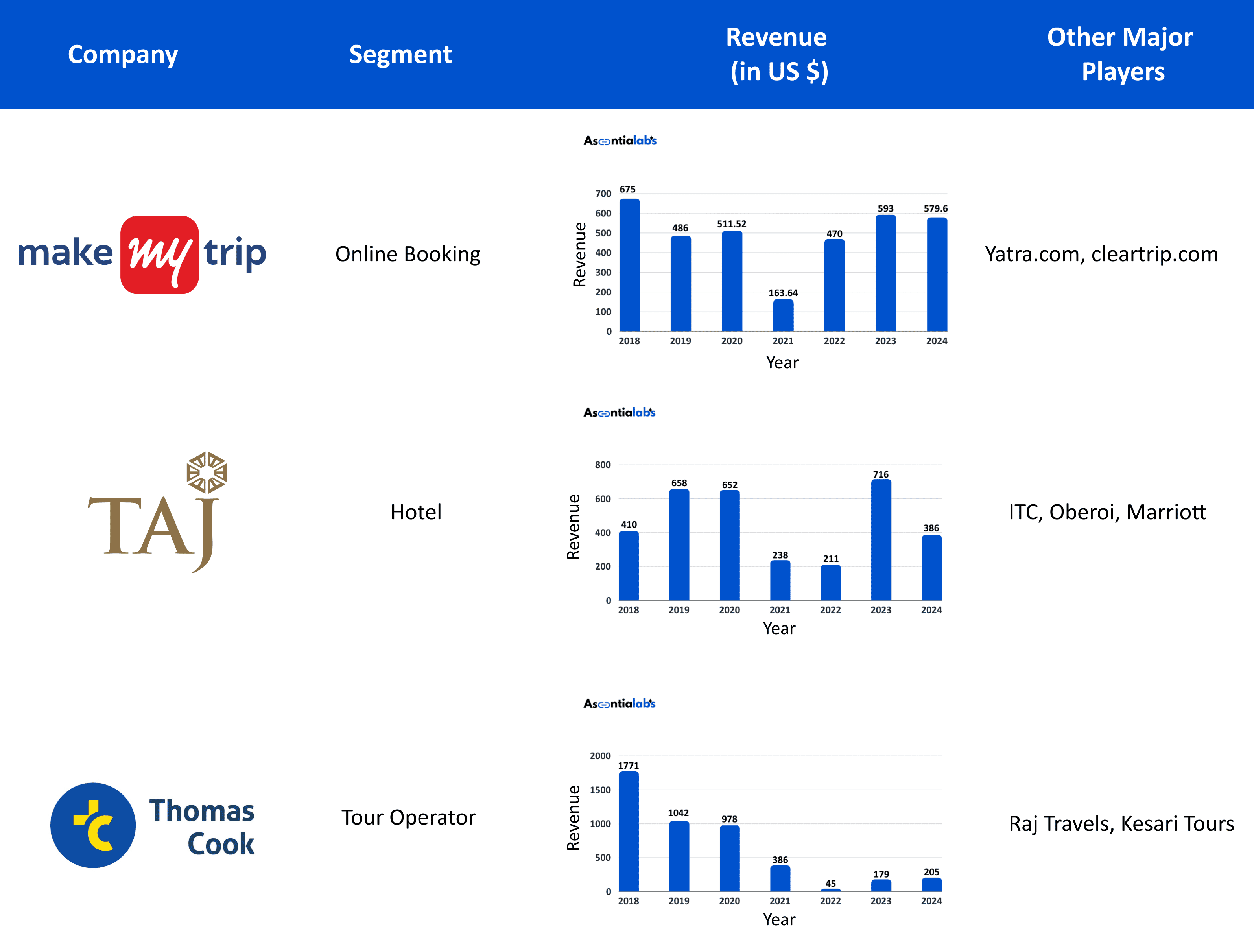
Airlines Industry Poised For Significant Growth
1. Low-Cost Airline Carriers
- Growth in the number of low-cost airline carriers will lower the overall air ticket fares and increase connectivity among different states in India. On 27th April 2017 UDAN (Ude Desh Ka Aam Naagrik), the scheme was launched under which 36 new airports were commissioned with 128 flight routes across 70 airports.
- Under UDAN 2.0, a helipad was added for the first time, and in 2018, 73 unserved airports were announced.
- In UDAN 3.0, several new changes were made including seaplanes to connect water aerodromes, tourist routes, and routes under "UDAN" in the North-East region of India.
- Under UDAN 4.0, 78 new travel routes were approved in 2020. Under UDAN 4.0 the Kavaratti, Agatti, and Minicoy islands of Lakshadweep were also connected by new travel routes.
2. Indian Airlines to Gain International Traffic
- According to a new report by CRISIL ratings, the reports predicted that by the fiscal year 2028, Indian airline carriers will hold roughly near about 50% of the Indian international passenger traffic market.
\Blog 2 Image 11.jpg)
3.Increase in the Number of Airports
- On 10th March, 2024 our honorable Prime Minister Narendra Modi inaugurated 15 new airport projects including new terminal buildings at 12 existing airports such as Delhi, Lucknow, and Pune. The Indian government is also planning to have a total of 225 airports across the country by 2025.
4.Higher Investment/Government Support
- In the interim budget of 2024, finance minister Nirmala Sitharaman allocated Rs. 2449.62 crore (US$ 294.8 Million) to the travel tourism sector, a nearly 44.7% increase from the previous fiscal year.
Further Dipak Diva, MD of Travel Corporation of India at an event called "Tres 2024" said that to improve the accessibility and connectivity of foreign tourists to India, from January 2026 Air India is going to play a major role in increasing inbound tourism to India as the company has signed a deal to acquire 470 aircraft from Airbus and Boeing.
Conclusion
Looking at the above stats and insights it looks like the Travel and Tourism sector in India will have a promising going further in the future. With the inauguration of new airports and the enhancements in the number of flights, it is expected that it will improve the overall air connectivity thereby attracting more domestic and international tourists.
Looking at the bigger picture, it looks like the travel tourism sector is poised to evolve in the future, and this sector is expected to create many new jobs in India and will contribute significantly to India's economic growth.
Return To Blogs
 Arham Jain
Arham Jain
.png) 18/06/2024
18/06/2024
 7 min
7 min
.png)

